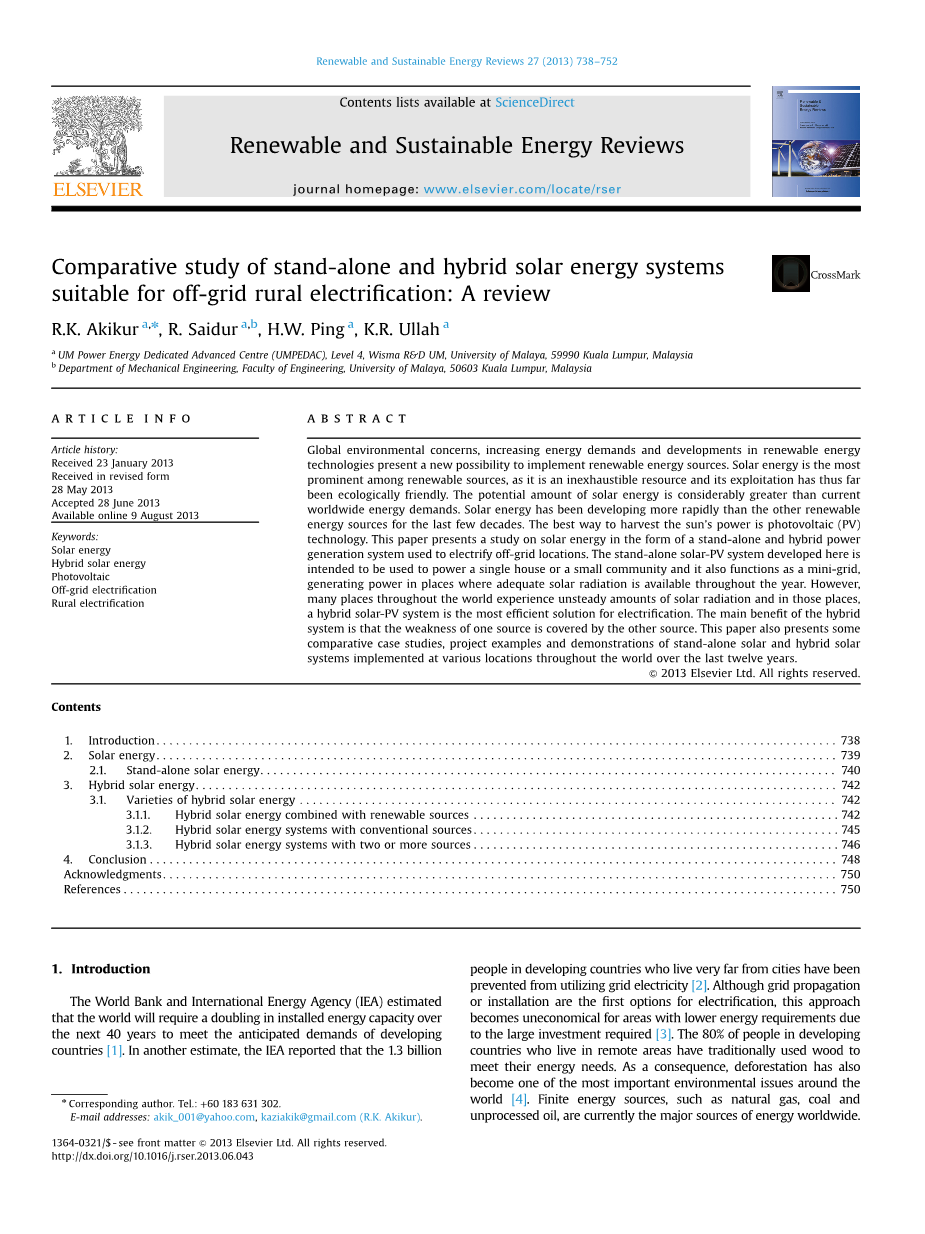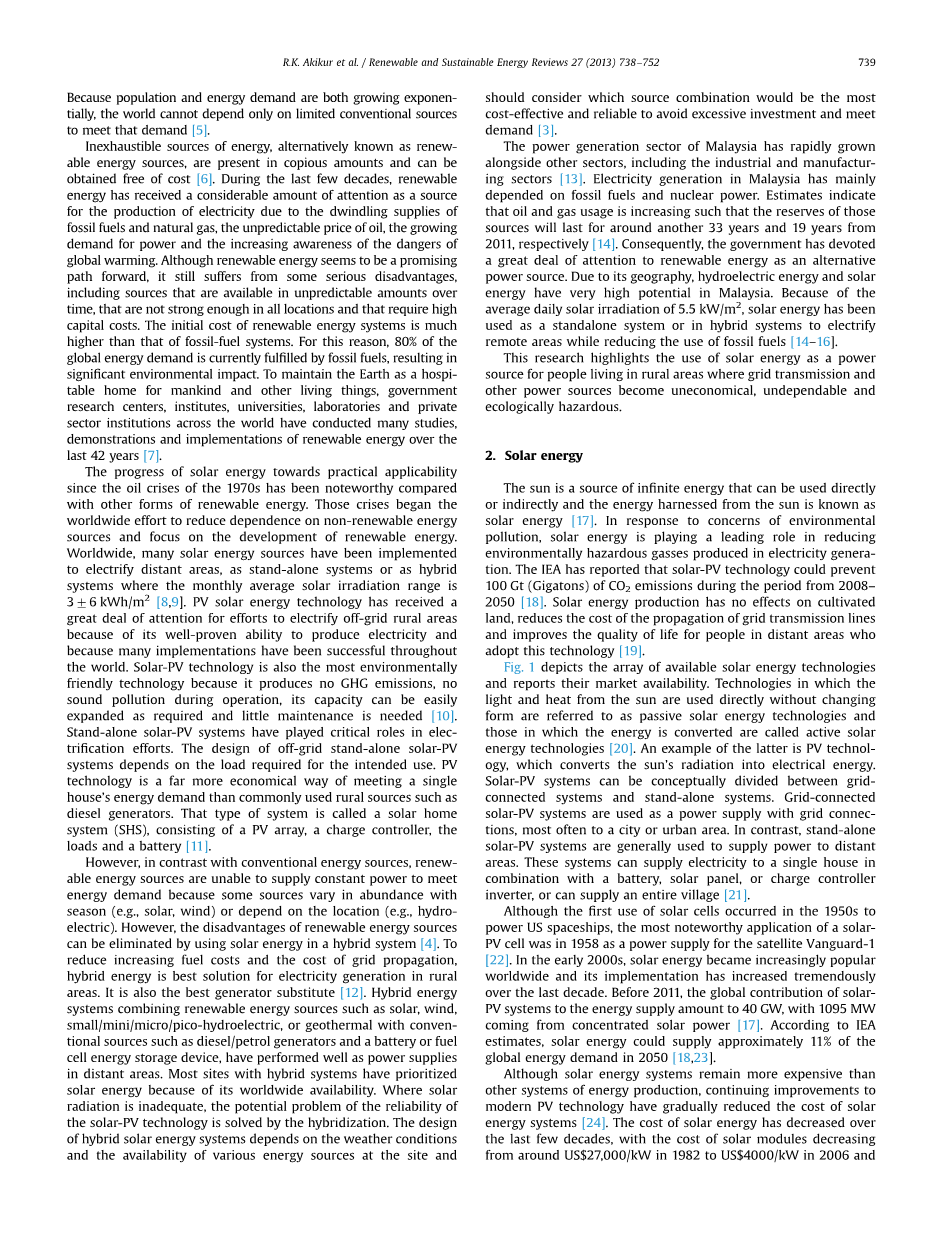本科毕业设计(论文)
外文翻译
Comparative study of stand-alone and hybrid solar energy systems suitable for off-grid rural electrification: A review
作者:R.K. Akikur a,n, R. Saidur a,b, H.W. Ping a, K.R. Ullah
国籍:Malaysia et al.
出处:Renewable and Sustainable Energy Reviews
原文正文:
Abstract
Global environmental concerns, increasing energy demands and developments in renewable energy technologies present a new possibility to implement renewable energy sources. Solar energy is the most prominent among renewable sources, as it is an inexhaustible resource and its exploitation has thus far been ecologically friendly. The potential amount of solar energy is considerably greater than current worldwide energy demands. Solar energy has been developing more rapidly than the other renewable energy sources for the last few decades. The best way to harvest the sunrsquo;s power is photovoltaic (PV) technology. This paper presents a study on solar energy in the form of a stand-alone and hybrid power generation system used to electrify off-grid locations. The stand-alone solar-PV system developed here is intended to be used to power a single house or a small community and it also functions as a mini-grid,generating power in places where adequate solar radiation is available throughout the year. However,many places throughout the world experience unsteady amounts of solar radiation and in those places, a hybrid solar-PV system is the most efficient solution for electrification. The main benefit of the hybrid system is that the weakness of one source is covered by the other source. This paper also presents some comparative case studies, project examples and demonstrations of stand-alone solar and hybrid solar systems implemented at various locations throughout the world over the last twelve years.
1. Introduction
The World Bank and International Energy Agency (IEA) estimated that the world will require a doubling in installed energy capacity over the next 40 years to meet the anticipated demands of developing countries [1]. In another estimate, the IEA reported that the 1.3 billion people in developing countries who live very far from cities have been prevented from utilizing grid electricity [2]. Although grid propagation or installation are the first options for electrification, this approach becomes uneconomical for areas with lower energy requirements due to the large investment required [3]. The 80% of people in developing countries who live in remote areas have traditionally used wood to meet their energy needs. As a consequence, deforestation has also become one of the most important environmental issues around the world [4]. Finite energy sources, such as natural gas, coal and unprocessed oil, are currently the major sources of energy worldwide.Because population and energy demand are both growing exponentially, the world cannot depend only on limited conventional sources to meet that demand [5].
Inexhaustible sources of energy, alternatively known as renewable energy sources, are present in copious amounts and can be obtained free of cost [6]. During the last few decades, renewable energy has received a considerable amount of attention as a source for the production of electricity due to the dwindling supplies of fossil fuels and natural gas, the unpredictable price of oil, the growing demand for power and the increasing awareness of the dangers of global warming. Although renewable energy seems to be a promising path forward, it still suffers from some serious disadvantages, including sources that are available in unpredictable amounts over time, that are not strong enough in all locations and that require high capital costs. The initial cost of renewable energy systems is much higher than that of fossil-fuel systems. For this reason, 80% of the global energy demand is currently fulfilled by fossil fuels, resulting in significant environmental impact. To maintain the Earth as a hospitable home for mankind and other living things, government research centers, institutes, universities, laboratories and private sector institutions across the world have conducted many studies, demonstrations and implementations of renewable energy over the last 42 years [7].
The progress of solar energy towards practical applicability since the oil crises of the 1970s has been noteworthy compared with other forms of renewable energy. Those crises began the worldwide effort to reduce dependence on non-renewable energy sources and focus on the development of renewable energy. Worldwide, many solar energy sources have been implemented to electrify distant areas, as stand-alone systems or as hybrid systems where the monthly average solar irradiation range is 376 kWh/m2 [8,9]. PV solar energy technology has received a great deal of attention for efforts to electrify off-grid rural areas because of its well-proven ability to produce electricity and because many implementations have been successful throughout the world. Solar-PV technology is also the most environmentally friendly technology because it produces no GHG emissions, no sound pollution during operation, its capacity can be easily expanded as required and little maintenance is needed [10]. Stand-alone solar-PV systems have played critical roles in electrification efforts. The design of off-grid stand-alone solar-PV systems depends on the load required for the intended use. PV technology is a far more economical way of meeting a single housersquo;s energy demand than commonly used rural sources such as diesel generators. That type of system is called a solar home system (SHS), consisting of a PV array, a charge controller, the lo
剩余内容已隐藏,支付完成后下载完整资料


英语原文共 15 页,剩余内容已隐藏,支付完成后下载完整资料
资料编号:[273096],资料为PDF文档或Word文档,PDF文档可免费转换为Word
以上是毕业论文外文翻译,课题毕业论文、任务书、文献综述、开题报告、程序设计、图纸设计等资料可联系客服协助查找。


